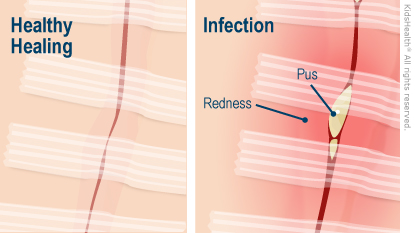During open heart surgery, the surgeon made an incision (cut) in the skin and muscles and opened the sternum (breastbone). After the surgery, the surgeon used stitches or small steel wires to close the breastbone, and stitches to pull the skin and muscles together
Follow these care instructions to prevent infection and help your child heal.

- Follow your surgeon's advice for:
- when/what your child can eat
- what to give your child for pain
- cleaning the incision
- the best way for your child to bathe
- any movement or stretching exercises for your child
- any activities that your child should avoid
- when your child can go back to daycare or school
- when to follow up
- It's safe for your baby or child to use the car seat, booster seat, or seatbelt that is appropriate for their age and size.
- Don't use lotion or powder on the incision area.
- Don't pick at scabs or let your child pick at or scratch them.
- Don't let the incision get direct sunlight for 1 year after the surgery. After that, apply broad-spectrum, water-resistant sunscreen with SPF 30 or higher to the scar every time your child is out in the sun.
Special Instructions for Babies
- To lift your baby, use a scoop lift — hold your baby under their buttocks and upper back. Do not lift your baby by pulling on their arms or from under the armpits.
- Your baby will do things like rolling, crawling, lifting their arms, and sitting up when it's not painful for them. Support them as they go at their own pace. For example, if your baby sits up, gently support them until they seem comfortable without your help.
- You can hold your baby as usual during breastfeeding or bottle-feeding.
- You can hold your baby chest-to-chest to comfort or burp them.
- Babies younger than about 7 months old need tummy time (lying on their belly) to develop their back and neck muscles. About 2 weeks after surgery, see if your baby is comfortable with tummy time. At first, try it for a short time. If your baby does not seem uncomfortable, you can slowly increase the time. By about 3 months old, your baby should be on their belly 4–6 times a day for about 5–15 minutes at a time. Stay with your baby during tummy time.
- Place your baby to sleep as usual. All babies younger than 1 year old should be placed on their back to sleep on a firm mattress without any toys or blankets. This lowers their risk of sudden infant death syndrome (SIDS).

Your child:
- has a fever
- vomits or has diarrhea more than a few times
- is not eating/breastfeeding/taking a bottle as usual
- is very sleepy or cranky
- has signs of infection along the incision (redness, swelling, or discharge)
You know your child best. Call the surgeon if you see any signs that worry you.

Your child has:
- shortness of breath, fast breathing, noisy breathing, or trouble breathing
- a skin color change (pale, bluish)
Also go to the ER if the stitches, staples, or wires are loose or the incision starts to open.

How will I know if my child's incision is infected? An infected incision will get red and swollen, seem sore, and/or have discharge (pus) coming through the stiches, staples, or wires. An infection also can cause a fever and make a child seem fussier than usual. Call your surgeon if your child has any of these signs.
How else can I help my child heal? Preventing other infections (such as a cold) can help your child stay healthy while healing from surgery. To prevent infections:
- Have your child and all family members wash hands well and often. Use soap and wash for at least 20 seconds, rinse, then dry with a clean towel. If soap isn't available, you can use a hand sanitizer with at least 60% alcohol.
- Keep your child home from school and avoid crowds (such as in church, grocery stores, or the mall) until the surgeon says it's OK.
- Do not let anyone who is sick or who has been sick in the last week or two visit your child.




